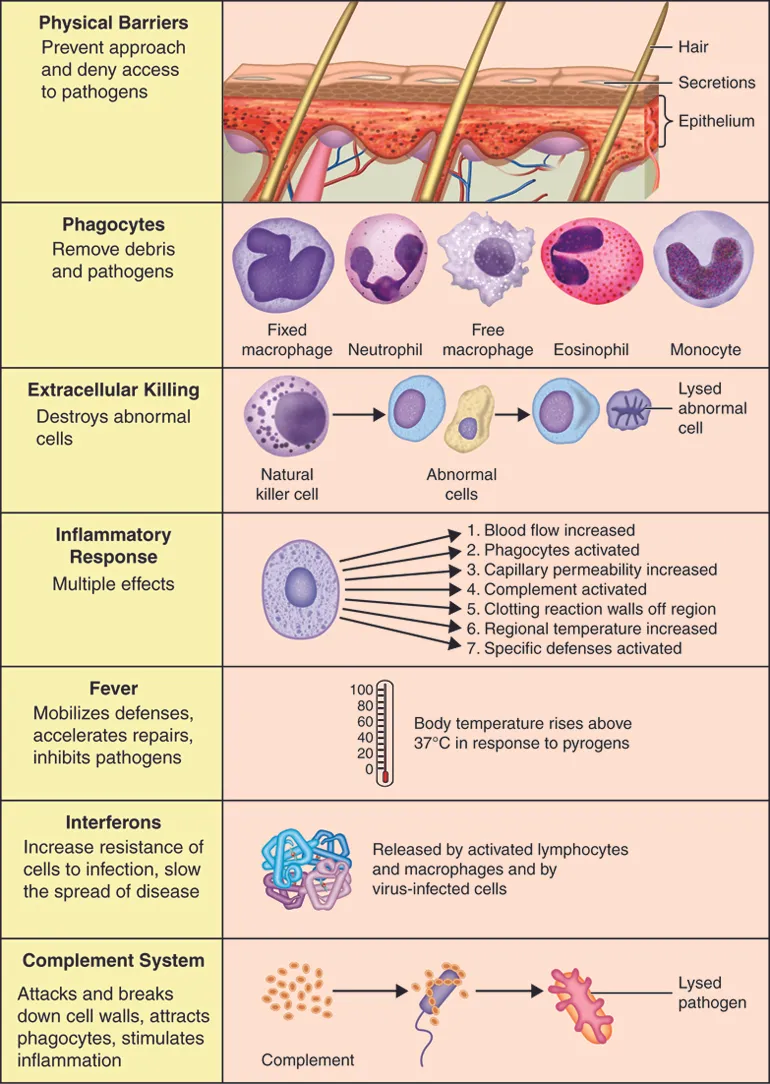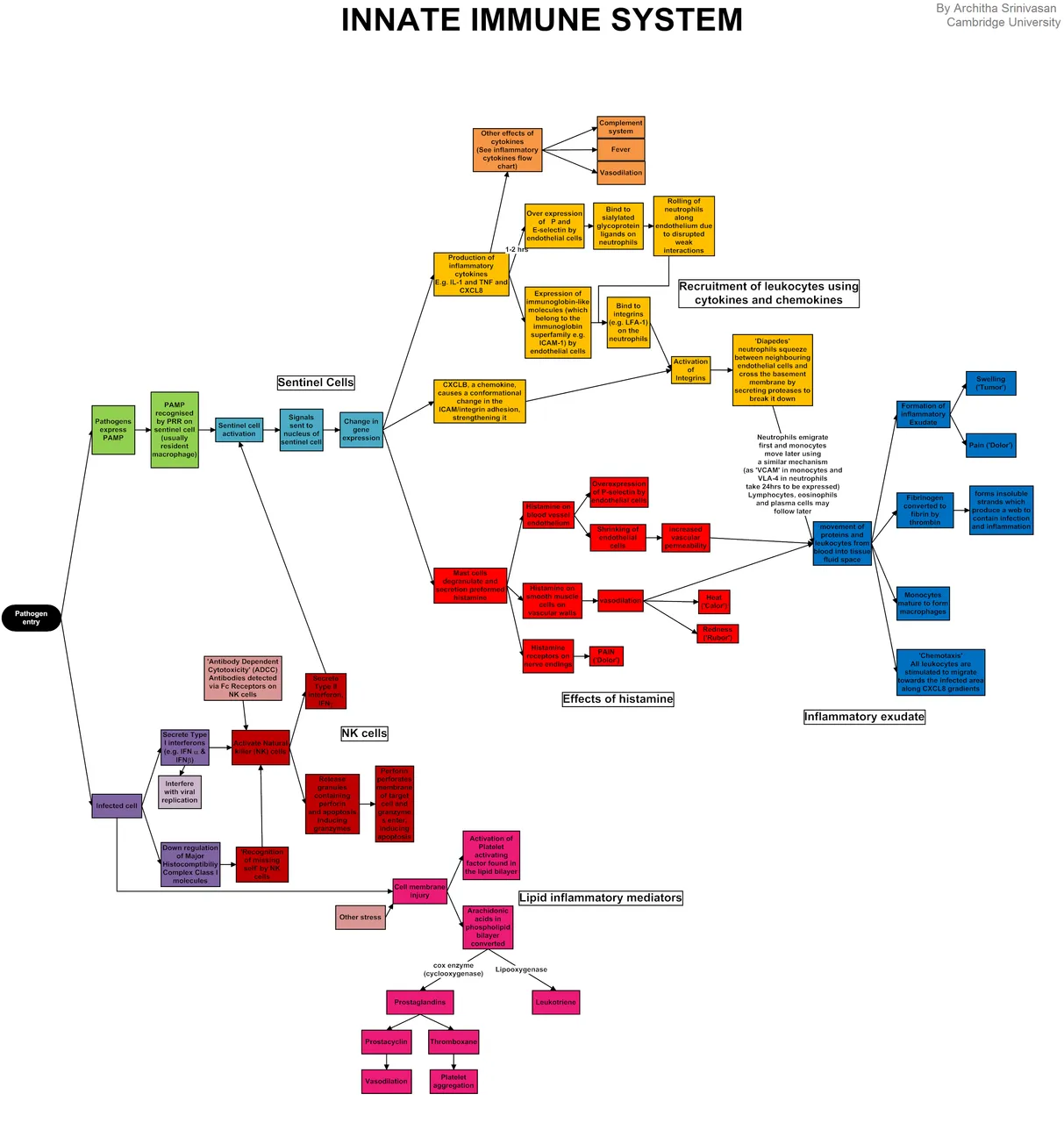When we discuss the immune system, we are looking into how the body fights against pathogens that evade it. Such pathogens include bacteria, viruses, parasites, and fungi. The body is built to defend us from dying and that is why there possesses an immune system. The immune system comprises the innate immune system and the adaptive immune system. In this post, I will be looking into the innate immune system but before I continue, let me do a fast touch on the adaptive arm of the immune system. The adaptive immune system is a specific response immune system that targets specifically a pathogen destroying the pathogen which it senses as foreign but on the other hand, the innate immune system isn't specific. It attacks pathogens without any specific target to one type and it doesn't keep a memory of whatever pathogen it attacks and it is the first line of defense for the body. So let's do the innate system.
The innate immune system is made up of the external division which comprises the skin and mucus membranes, and the internal division which is made up of the cellular defenses, chemicals, and physiological responses.

https://pressbooks.ccconline.org
The external division of the innate immune system starts with the skin, and the outer part of the skin is the epidermis which is made up of epithelial cells. The body is made up of four tissue types which include epithelial, connective, muscle, and nervous tissue. The skin is made up of the stratified squamous epithelial (which is the dead multi-layer part of the skin), it is also made up of a sebaceous oil gland which makes the skin oily and it is a protective property against microbial agents. The oil is made up of unsaturated fatty acids which is a poor energy source for microorganisms, and the gland has a pH between 3 and 5 which which is acidic. Sweat which is also salty is not a good agent for microbial growth, making it a part of the skin's innate immune system as well. The skin also secretes mucus, tear, and saliva which have enzymes lysozymes and defensin which destroy invading pathogens in the eye, the nasal, and the oral cavity. In the nasal cavity are little hairs known as cilia which also act as a defense system.
If the pathogens get into the skin, the body will not allow them to kill us just like that. The body will always try its best to fight these pathogens and foreign bodies inside the body. The cells would come to the body's defense, and this is where phagocytes come into the picture. Phagocytes as its name implies are cells that engulf or eat up things, so they literally eat microorganisms. Phagocytes include neutrophils and macrophages. Neutrophils are part of the white blood cells which are made up of neutrophils, lymphocytes, monocytes, eosinophils, and basophils. It engulfs the microorganisms usually bacteria and they usually get to the region of attack very fast. Macrophages also attack the microorganisms, engulf them and destroy them. Macrophages can be wandering macrophages such as monocytes or fixed macrophages such as histiocytes which are in connective tissues, Kupfer cells in the liver, alveolar cells in the lung, and microglia which are found in the nervous system. Unlike neutrophils, macrophages are antigen-presenting cells allowing for an adaptive immune system to attack and destroy pathogens. Still-on cells are natural killer cells that target and destroy pathogens as they release perforins (perforating the cells causing the cell to contain fluid), and granzymes (which trigger the cell to undergo apoptosis).
In the body are chemicals that also combat microorganisms. Chemicals in the body that perform these activities include Complement proteins which complement aspects of the innate division of the immune system such as causing phagocytes to get to the region. Cytokines are another chemical being released to combat microorganisms. These cytokines include interleukins, interferons, tumor necrosis factor, and so on, and they complement both the innate and adaptive immune systems to attack pathogens. for instance, Interleukins allow for the response of white blood cells to attack cells invaded by viruses.
The body also has the physiological response of innate immune response. These include inflammation and fever. Inflammation in the body can be good or bad. When it has to do with an attack on pathogens and a recovery process, it can be good in the short term, but in the long term, it can be bad as it damages the system. This is similar to having that annoying but fun to be with friends over for a holiday, when he arrives, he is fun to be in the short term, but in the long term, he can start destroying your friendship. Inflammation is damage to vascularized tissue, so it is important to know that non-vascularized tissues such as cartilage do not experience inflammation. it is also important in the regeneration and fixing of damaged tissues. Damaged tissues will release prostaglandins, histamine, or bradykinins depending on the tissue being damaged, and they trigger the blood vessel to dilate allowing more blood cells to rush to the area and increasing vascular permeability allowing the white blood cells to reach the tissues as they leave the blood vessels. Inflammation comes with redness, swelling, heat, and pain which can be found both during the attack of pathogens and during recovery.
Fever is another physiological response to pyrogens as they stimulate heat. Pyrogens can be cytokines or pathogens themselves. They are released and travel to the hypothalamus at the base of the brain which regulates body temperature and controls the autonomic nervous system, and the endocrine system. Fever increases the function of the immune cells, and decreases the pathogen's ability to reproduce.
This said, in conclusion, the skin is the first defense for pathogens, it covers almost the entire body. The innate immune system consists of immune mechanisms that recognize and neutralizes a broad range of pathogenic threat quickly. The adaptive system relies on specific antigen defenses and would remember the antigen if it gets into the body again.
- https://www.ncbi.nlm.nih.gov/books/NBK279396/
- https://www.ncbi.nlm.nih.gov/books/NBK499819/
- https://www.ncbi.nlm.nih.gov/pmc/articles/PMC6283644/
- https://journals.asm.org/doi/10.1128/cmr.00034-18
- https://www.ncbi.nlm.nih.gov/books/NBK459455/
- https://blog.cellsignal.com/immunology-how-does-the-innate-immune-system-work
- https://aacijournal.biomedcentral.com/articles/10.1186/s13223-018-0278-1
- https://ashpublications.org/blood/article/118/1/9/28431/Cytokine-release-from-innate-immune-cells
- https://www.ncbi.nlm.nih.gov/pmc/articles/PMC150916/
